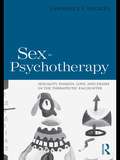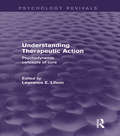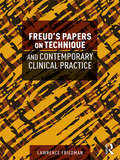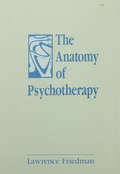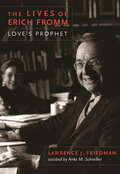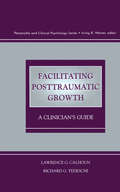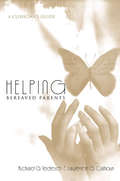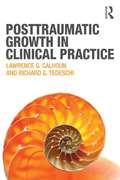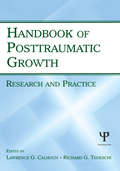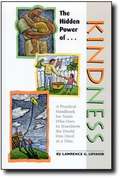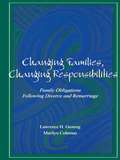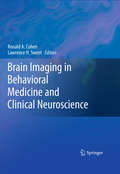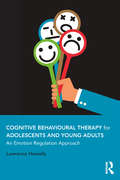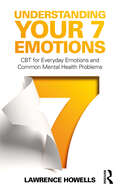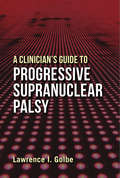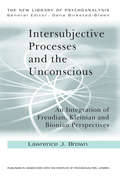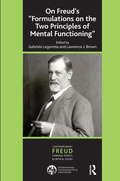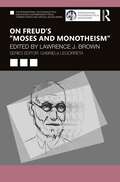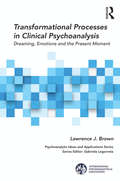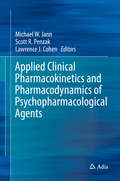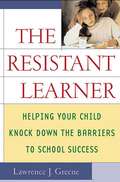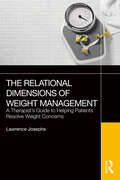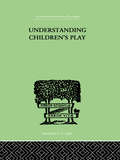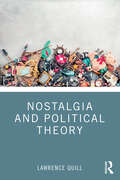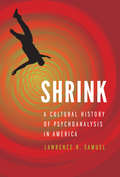- Table View
- List View
Sex in Psychotherapy: Sexuality, Passion, Love, and Desire in the Therapeutic Encounter
by Lawrence E. HedgesSex in Psychotherapy takes a psychodynamic approach to understanding recent technological and theoretical shifts in the field of psychotherapy. Lawrence Hedges provides an expert overview and analysis of a wide variety of new perspectives on sex, sexuality, gender, and identity; new theories about sex’s role in therapy; and new discoveries about the human brain and how it works. Therapists will value Hedges’s unique insights into the role of sexuality in therapy, which are grounded in the author’s studies of neurology, the history of sexuality, transference, resistance, and countertransference. Clinicians will also appreciate his provocative analyses of influential perspectives on sex, gender, and identity, and his lucid, concrete advice on the practice of therapeutic listening.
Understanding Therapeutic Action: Psychodynamic Concepts of Cure (Psychology Revivals)
by Lawrence E. LifsonMost of the existing psychodynamic literature approaches the treatment process from one particular theoretical perspective or another. Yet, what contemporary psychotherapists need most is practical information that transcends individual perspectives. After all, they must be able to treat patients who suffer from structural conflict, structural deficit, and relational conflict, and they must be able to understand the theories of therapeutic action associated with these concepts of psychopathology in relation to one another. Originally published in 1996, Understanding Therapeutic Action: Psychodynamic Concepts of Cure both surveys different theories of therapeutic action and offers an integrative model of treatment. Editor Lawrence E. Lifson has brought together contributors who are among the leading theoreticians and practitioners of psychodynamic psychotherapy. Their chapters’ cover all the major perspectives on therapeutic action and are organized into sections covering structural and object relations theories; the self as the focus of therapeutic action; and an integrative approach to the concept of cure. The emphasis throughout is on the translation of theory into clinical practice, with attention given to the contributions of patient and therapist alike in the curative process. Providing clinicians with a comprehensive overview and synthesis of the different models of therapeutic action, this collection is an illuminating exercise in comparative psychotherapy and a valuable tool for enhancing the applicability and effectiveness of clinical work.
Freud's Papers on Technique and Contemporary Clinical Practice
by Lawrence FriedmanFreud’s Papers on Technique is usually treated as an assemblage of papers featuring a few dated rules of conduct that are either useful in some way, or merely customary, or bullying, arbitrary and presumptuous. Lawrence Friedman reveals Papers on Technique to be nothing of the sort. Freud’s book, he argues, is nothing less than a single, consecutive, real-time, log of Freud’s painful discovery of a unique mind-set that can be produced in patients by a certain stance of the analyst. What people refer to as "the rules", such as anonymity, neutrality and abstinence, are the lessons Freud learned from painful experience when he tried to reproduce the new, free mind-set. Friedman argues that one can see Freud making this empirical discovery gradually over the sequence of papers. He argues that we cannot understand the famous images, such the analyst-as-surgeon, or mirror, without seeing how they figure in this series of experiments. Many of the arguments in the profession turn out to be unnecessary once this is grasped. Freud’s book is not a book of rules but a description of what happens if one does one thing or another; the choice is the therapist’s, as is the choice to use them together to elicit the analytic experience. In the light of this understanding, Friedman discusses aspects of treatments that are guided by these principles, such as enactment, the frame, what lies beyond interpretation, the kind of tensions that are set up between analyst and patient, the question of special analytic love, the future of analytic technique, and a possible basis for defining Freudian psychoanalysis. Finally, he makes concrete suggestions for teaching the Papers on Technique. Freud's Papers on Technique and Contemporary Clinical Practice will appeal to all psychoanalysts and psychoanalytic psychotherapists concerned about the empirical basis of their customary procedures and the future of their craft.
The Anatomy of Psychotherapy
by Lawrence FriedmanOver the past decades, Lawrence Friedman has emerged as one of the most erudite and provocative theoriss in contemporary psychotherapy. The Anatomy of Psychotherapy interweaves Friedman's major contributions to the analytic and psychiatric literature with extensive new material in arriving at an extraordinarily rich and nuanced appreciation of psychotherapy. The Anatomy of Psychotherapy describes how the therapist makes use of theories and styles in order to achieve equilibrium under stress. This stress, according to Friedman, is related to the "absolute ambiguity" that is essential to psychotherapy. To cope with this ambiguity, the therapist alternates among three different roles, those of reader, historian, and pragmatic operator. Friedman examines these "disambiguating postures" in detail, paying special attention to their bearing on the therapist's narrative prejudice, the relativity of his knowledge, and the relationship of his work to natural science and hermeneutics. Brilliantly constructed and masterfully written, The Anatomy of Psychotherapy traverses the same basic themes in each of its six sections. Readers who are interested in theory can hone in on relevant topics or the work of particular theorists. Readers seeking insight into the demands of daily clinical work, on the other hand, can bypass the systematic studies and immerse themselves in Friedman's engrossing reflections on the experience of psychotherapy. Best served will be those who ponder Friedman's writings and therapy as complementary meditations issuing from a single, unifying vision, one in which psychotherapy, in both its promise and frustrations, becomes a subtle interplay among theories about psychotherapy, the personal styles of psychotherapists, and the practical exigencies of aiding those in distress.
The Lives of Erich Fromm: Love's Prophet
by Lawrence FriedmanErich Fromm was a political activist, psychologist, psychoanalyst, philosopher, and one of the most important intellectuals of the twentieth century. Known for his theories of personality and political insight, Fromm dissected the sadomasochistic appeal of brutal dictators while also eloquently championing love—which, he insisted, was nothing if it did not involve joyful contact with others and humanity at large. Admired all over the world, Fromm continues to inspire with his message of universal brotherhood and quest for lasting peace.The first systematic study of Fromm's influences and achievements, this biography revisits the thinker's most important works, especially Escape from Freedom and The Art of Loving, which conveyed important and complex ideas to millions of readers. The volume recounts Fromm's political activism as a founder and major funder of Amnesty International, the National Committee for a Sane Nuclear Policy, and other peace groups. Consulting rare archival materials across the globe, Lawrence J. Friedman reveals Fromm's support for anti-Stalinist democratic movements in Central and Eastern Europe and his efforts to revitalize American democracy. For the first time, readers learn about Fromm's direct contact with high officials in the American government on matters of war and peace while accessing a deeper understanding of his conceptual differences with Freud, his rapport with Neo-Freudians like Karen Horney and Harry Stack Sullivan, and his association with innovative artists, public intellectuals, and world leaders. Friedman elucidates Fromm's key intellectual contributions, especially his innovative concept of "social character," in which social institutions and practices shape the inner psyche, and he clarifies Fromm's conception of love as an acquired skill. Taking full stock of the thinker's historical and global accomplishments, Friedman portrays a man of immense authenticity and spirituality who made life in the twentieth century more humane than it might have been.
Facilitating Posttraumatic Growth: A Clinician's Guide
by Lawrence G. Calhoun Richard G. TedeschiIn this book, Calhoun and Tedeschi construct the first systematic framework for clinical efforts to enhance the processes they sum up as posttraumatic growth. Posttraumatic growth is the phenomenon of positive change through struggle with even the most horrible sets of circumstances. People who experience it tend to describe three general types of change: realistically stronger feelings of vulnerability that are nonetheless accompanied by stronger feelings of personal resilience, closer and deeper relationships with others, and a stronger sense of spirituality. Posttraumatic growth has only recently become an important focus of interest for researchers and practitioners. Drawing on a burgeoning professional literature as well as on their own extensive clinical experience, the authors present strategies for helping clients effect all three types of positive change--strategies that have been tested in a variety of groups facing a variety of crises and traumas. Their concise yet comprehensive practical guide will be welcomed by all those who counsel persons grappling with the worst life has to offer.
Helping Bereaved Parents: A Clinician's Guide (Series in Death, Dying, and Bereavement)
by Lawrence G. Calhoun Richard G. TedeschiThis book provides a concise, yet comprehensive guide to effective work with bereaved parents, combining a broad overview of current research, theory, and practice with the authors' own extensive clinical experience. Transcripts of individual, couple, and group meetings illustrate the delicate subtleties of this work, giving the reader helpful insights into more effective clinical practice. The authors emphasize the importance of approaching each parent as a unique person, while also considering the socio-cultural context of the bereaved. This book helps clinicians approach work with bereaved parents with a less scripted format, suggesting an alternative role as expert companion to the bereaved, allowing for a more uplifting experience for both parties.
Posttraumatic Growth in Clinical Practice
by Lawrence G. Calhoun Richard G. TedeschiFrom the authors who pioneered the concept of posttraumatic growth comes Posttraumatic Growth in Clinical Practice, a book that brings the study of growth after trauma into the twenty-first century. Clinicians will find a framework that’s easy to use and flexible enough to be tailored to the needs of particular clients and specific therapeutic approaches. And, because it utilizes a model of relating described as "expert companionship," clinicians learn how to become most empathically effective in helping a variety of trauma survivors. Clinicians will come away from this book having learned how to assess posttraumatic growth, how to address it in treatment, and they’ll also have a basic grasp of the ways the changes they’re promoting will be received in various cultural contexts. Case examples show how utilizing a process developed from an empirically-based model of posttraumatic growth can promote important personal changes in the aftermath of traumatic events.
Handbook of Posttraumatic Growth: Research and Practice
by Lawrence G. Calhoun and Richard G. TedeschiPosttraumatic growth is an area in which investigations are now being undertaken in many different parts of the world. The view that individuals can be changed--sometimes in radically good ways--by their struggle with trauma is ancient and widespread. However, the systematic focus by scholars and clinicians on the possibilities for growth from the struggle with crisis is relatively recent. There are now a growing number of studies and scholarly papers on the antecedents, correlates, and consequences of posttraumatic growth, and there are also theoretical models that can help guide the research further. It is clear, however, that this phenomenon is not yet well understood.The Handbook of Posttraumatic Growth: Research and Practice provides both clinicians and researchers with a comprehensive and up-to-date view of what has been done so far. In addition, it uses the foundations of what has been done to provide suggestions for the next useful steps to take in understanding posttraumatic growth. The book offers contributions of important and influential scholars representing a wide array of perspectives of posttraumatic growth. This volume serves as an impetus for additional work, both in the academic aspects and in the possibilities for clinical applications of posttraumatic growth.This Handbook will appeal to students, practitioners, and researchers working in a broad array of disciplines and human services.
The Hidden Power of Kindness: A Practical Handbook for Souls Who Dare to Transform the World, One Deed at a Time
by Lawrence G. LovasikIf you want to make progress in the spiritual life, don't miss these insights: they'll give you years of solid help to grow in charity and truly transform your corner of the world.
Changing Families, Changing Responsibilities: Family Obligations Following Divorce and Remarriage
by Lawrence Ganong Marilyn ColemanThis book explores the topic of family obligations following changes in family structure caused by divorce and remarriage. Family obligations are commonly defined as the rights and duties that accompany family roles. They have been described as the "glue" that connects generations, as well as the "oughts" and "shoulds" that surround individual family relationships. This book is primarily concerned with normative beliefs about what family members should do for each other. It differs from previous accounts of family obligation norms because it specifically focuses on family responsibilities after divorce and remarriage, two events that affect an increasing number of families today. The authors draw extensively upon the findings of 13 studies of normative beliefs regarding post-divorce intergenerational family obligations. This book fills a gap in the present literature concerning family obligation. It addresses the weaknesses of prior research by focusing on family transitions and by presenting data from studies that employ contextual methods. The content will provide guidance to policymakers and helping professionals who work with families, and the unique focus and procedures of the studies are likely to set the standard for future assessments of normative beliefs about family obligations.
Brain Imaging in Behavioral Medicine and Clinical Neuroscience
by Ronald A. Cohen Lawrence H. SweetRapid developments in brain neuroimaging methods have occurred over the past decade. These advances have revolutionized cognitive and behavioral neuroscience, and are likely to have major influence on clinical psychological, psychiatric, and neurological practice over the coming years. There are a number of excellent books that focus on specific neuroimaging methods, such as fMRI. Furthermore, cognitive and neuroscience texts have increasingly incorporated functional brain neuroimaging. Yet, there are few books to date that consider and review emerging research in the application of brain neuroimaging methods for the study and assessment of behavioral and cognitive disorders. This book provides a broad coverage of current research trends in the clinical application of brain neuroimaging methods in the context of behavioral medicine, neuropsychology, and related areas of medical psychology. It uniquely integrates current neuroimaging methods and studies with current behavioral medicine research, and presents knowledge derived from recent developments in the fields of functional and structural brain imaging. By integrating information from experimental behavioral medicine with clinical insights, this book will serve as a source book for neuropsychologists, psychologists, neurologists, psychiatrists, and other professionals in both clinical practice and academic context. This integration results in the reader having a greater understanding of how the brain controls behavior, the disturbances of behavior that may occur with different disorders, and what clinicians should consider when assessing or working with patients with behavioral problems.
Cognitive Behavioural Therapy for Adolescents and Young Adults: An Emotion Regulation Approach
by Lawrence HowellsCognitive Behavioural Therapy for Adolescents and Young Adults: An Emotion Regulation Approach provides a unique focus on therapeutic practice with adolescents and young adults, covering everything from psychological theories of adolescence to the treatment of common emotional difficulties. Beginning with a review of development through adolescence into adulthood, and the principles of CBT, the book highlights problems with traditional models of CBT for adolescents and young adults. In a fresh approach, this book separates CBT from diagnosis and grounds it instead in emotion science. Adolescents and young adults learn not about disorders and symptoms, but about emotions, emotional ‘traps’, and how they can use CBT to bring about change. There are chapters on fear, sadness, anger, emotion dysregulation, and happiness. Each chapter provides an outline of emotion science, a clear cognitive behavioural formulation (‘trap’), and evidence-based interventions. Clinicians are walked through the process using case illustrations. Cognitive Behavioural Therapy for Adolescents and Young Adults represents a transformation of CBT practice, and will become a valuable treatment manual to training and practising mental health professionals, especially psychotherapists specialising in CBT.
Understanding Your 7 Emotions: CBT for Everyday Emotions and Common Mental Health Problems
by Lawrence HowellsUnderstanding Your 7 Emotions explains how emotions help us to respond to the world around us and are fundamental to our existence. The book provides a detailed understanding of the main human emotions – fear, sadness, anger, disgust, guilt, shame and happiness – showing how to live with them and how to resolve problems with them. Each of the seven chapters also includes an ‘emotional trap’ to highlight what happens when we get stuck responding in unhelpful ways and explains how to get out of the trap. Grounded in emotion science and cognitive behavioural therapy, the book provides a powerful alternative to mental health diagnosis. Examples and exercises are provided throughout to help apply the ideas in everyday life and achieve health and happiness. This easy-to-read guide will help anybody who is interested in emotions or is struggling with common mental health problems to better understand how emotions work and improve their own and others' mental health and emotional wellbeing. It will also be an invaluable resource to those working in the caring professions.
A Clinician's Guide to Progressive Supranuclear Palsy
by Lawrence I. GolbeThis brief, clinically-focused volume is informed by Lawrence I. Golbe’s three decades of research and tertiary clinical care in progressive supranuclear palsy, a complex disorder with rapidly changing diagnostic and therapeutic approaches. It is an ideal source for the general neurologist seeking a refresher and the primary care provider, neurological nurse, or physical, occupational or speech therapist who must address their patients’ specialized needs. A Clinician’s Guide to Progressive Supranuclear Palsy emphasizes early diagnostic signs, medication options, non-pharmacologic management and palliative care. It offers a quick overview of the complications of PSP most likely to prompt an ER visit; a widening spectrum of PSP variants; and ample description of the genetics, epidemiology, natural history, pathology, molecular biology and neurochemistry of PSP. The PSP Rating Scale used in the book is a convenient tool for clinicians in routine practice and the leading PSP clinical measure world-wide. Golbe provides a practical and useful guidebook to help all clinicians learn and battle this complex disorder.
Intersubjective Processes and the Unconscious: An Integration of Freudian, Kleinian and Bionian Perspectives (The New Library of Psychoanalysis)
by Lawrence J. BrownIntersubjective Processes and the Unconscious looks at how the minds of the therapist and the patient interact with each other in a profound and unconscious way: a concept first described by Freud. This book expands Freud’s ideas further and examines how these have been greatly elaborated by contributions from the Kleinian School as well as from the work of Bion. It explores how, together, patient and therapist co-create a narrative through these unconscious intersubjective processes. Topics of discussion include: the unconscious dimensions of intersubjective processes an historical overview of Freudian, Kleinian and Bionian contributions an integrated theory of the nature of unconscious intersubjective processes the central importance of dreaming in intersubjective processes the clinical implications of this intersubjective model The author offers in-depth clinical examples and case vignettes to illustrate the application of these principles when working with trauma, countertransference dreams and supervision. As such, this book will be invaluable to all psychoanalysts and psychotherapists interested in the topic of intersubjectivity as well as those who want to learn more about the interactional dimensions of Freud, Klein and Bion.
On Freud's ''Formulations on the Two Principles of Mental Functioning'' (The International Psychoanalytical Association Contemporary Freud Turning Points and Critical Issues Series)
by Lawrence J. BrownThis book is a collection of papers by leading contemporary psychoanalysts who comment on the continuing important relevance of Freud's (1911) paper, Formulations on the Two Principles of Mental Functioning. The contributors gathered here represent current European, Latin American, and North American perspectives that elaborate the continuing value of Two Principles for present-day psychoanalytic thinking. Each author examines Freud's paper through a personal lens that is coloured by the psychoanalytic culture from which he or she comes. In each instance, the writers' chapters demonstrate the heuristic value of Two Principles for twenty-first century psychoanalytic theory and technique. A common thread that runs through all the chapters is the view that this brief paper by Freud, which he humbly introduced by stating, "The deficiencies of this short paper, which is preparatory rather than expository ...", is a masterpiece that contains within it the seeds of much of his later writing. The distinction he draws between the pleasure principle and the reality principle are profound and raise questions that still preoccupy analysis today.
On Freud’s “Moses and Monotheism”
by Lawrence J. BrownOn Freud’s "Moses and Monotheism" discusses key themes in Sigmund Freud’s final book, Moses and Monotheism, written between 1934 and 1939. The contributors reflect on the historical context of the time during which the book was written, including Freud’s mindset and his struggle to leave Austria to escape the Nazi regime, and investigate its contemporary implications and relevance. Drawing parallels with contemporary society, the chapters cover topics like historical truth, the effects of Nazism on Freud’s writing, Freud’s "relationship" with Moses, the transmission of trauma across generations, the origins and psychodynamics of anti-Semitism, Freud and Moses as leaders, and the notion of Tradition. This book also reflects on the stories of Moses and of Freud – the search of a people for a "Promised Land," the deep scars of slavery, and the struggle of a man to establish an ideology and ensure its continuity. On Freud’s "Moses and Monotheism" will be of great interest to all psychoanalysts and psychoanalytic psychotherapists. It will also be of interest to scholars investigating the nature of truth, and social scientists interested in the broader applications of Freud’s discussions of the nature of civilization.
Transformational Processes in Clinical Psychoanalysis: Dreaming, Emotions and the Present Moment (The International Psychoanalytical Association Psychoanalytic Ideas and Applications Series)
by Lawrence J. BrownIn this book, Lawrence J. Brown offers a contemporary perspective on how the mind transforms, and gives meaning to, emotional experience that arises unconsciously in the here-and-now of the clinical hour. Brown surveys the developments in theory and practice that follow from Freud’s original observations and traces this evolution from its conception to contemporary analytic field theory. Brown emphasizes that these unconscious transformational processes occur spontaneously, in the blink of an eye, through the "unconscious work" in which the analyst and patient are engaged. Though unconscious, these processes are accessible and the analyst must train himself to become aware of the subtle ways he is affected by the patient in the clinical moment. By paying attention to one’s reveries, countertransference manifestations and even supposed "wild" or extraneous thoughts, the analyst is able to obtain a glimpse of how his unconscious is transforming the ambient emotions of the session in order to formulate an interpretation. Brown casts a wide theoretical net in his exploration of these transformational processes and builds on the contributions of Freud, Theodor Reik, Bion, Ogden, the Barangers, Cassorla, Civitarese and Ferro. Bion’s theories of alpha function, transformations, dreaming and his clinical emphasis on the present moment are foundational to this book. Brown’s writing is clear and aims to describe the various theoretical ideas as plainly as possible. Detailed clinical material is given in most chapters to illustrate the theoretical perspectives. Brown applies this theory of transformational processes to a variety of topics, including the analyst’s receptivity, countertransference as transformation, the analytic setting, the paintings of J.M.W. Turner, "autistic transformations" and other clinical situations in the analysis of children and adults. Transformational Processes in Clinical Psychoanalysis will be of great interest to all psychoanalysts and psychoanalytic psychotherapists.
Applied Clinical Pharmacokinetics and Pharmacodynamics of Psychopharmacological Agents
by Lawrence J. Cohen Michael W. Jann Scott R. PenzakThisbook is a comprehensive resource on psychotropic medications, detailing thelatest methods for defining their characteristics, their use in differentpatient populations, and drug-drug interactions; an important collection ofinformation forclinicians, students, researchers, and members of thepharmaceutical industry alike. Thefirst section provides the foundational principles of these drugs. Mathematicalmodeling of parameters that affect their entryto,and exit from, the centralnervous system (CNS) compartment are presented on an individual basis and thenapplied to target populations with specific disease states. Methods andcharacteristics that inform the transfer of these drugs from the laboratorybench to use in patient care are discussed, including imaging techniques,genetics and physiological barriers, such as the blood-brain barrier. The secondsection describes the characteristics of specific agents,nominally arrangedintodifferent therapeutic categories and with reference crossover use indifferent disease states. The pharmacologic characteristics of different drugformulations are explored in the context of their ability to improve patientadherence. The third section focuses on drug-drug interactions. Psychotropic medicationsfrom different categories are frequently prescribed together,or alongsidemedications used to treat comorbid conditions, and the information provided isdirectly relevant to the clinic, as a result. Theclinical application of pharmacokinetics and pharmacodynamics of CNS agents hasmade significant progress over the past 50 years and new information is reportedby numerous publications in psychiatry, neurology, and pharmacology. Ourunderstanding of the interrelationship between these medications, receptors,drug transporters, as well as techniques for measurement and monitoring theirinteractions,isfrequently updated. However, with information presented on ahost of different platforms, and in different formats, obtaining the fullpicture can be difficult. This title aims to collate this information into asingle source that can be easily interpreted and applied towards patient careby the clinical practitioner, and act as a reference for all others who have aninterest in psychopharmacological agents.
The Resistant Learner
by Lawrence J. GreeneAddressing the emotional and academic needs of kids in grades four through twelve, Lawrence Greene examines the counterproductive behaviors and attitudes that undermine academic performance, diminish self-esteem and limit educational and career options. Each chapter focuses on a particular deficit area and offers accessible, hands-on methods for parents to guide and mentor their struggling child. Parents learn how to: * Help their child identify natural talents and use them when learning * Choose a democratic or autocratic approach to modifying behavior * Use the DIBS system to solve problems * Open an effective dialogue with their child * Express positive expectations and affirm and praise effort and progress * And much more
The Relational Dimensions of Weight Management: A Therapist’s Guide to Helping Patients Resolve Weight Concerns
by Lawrence JosephsThe Relational Dimensions of Weight Management is a book for nonspecialist psychotherapists of any theoretical orientation to help patients concerned with weight management. Psychotherapy patients use their therapists as sounding boards to help them answer two questions: Do I need to lose weight? And, if I do need to lose weight, how should I go about it? Chapters provide therapists with the tools they need to help patients find personalized solutions to their weight loss concerns, to boost their self-image, and to deal with the judgment that is sometimes imposed by others, regardless of which weight management approach patients eventually embrace.
Understanding Children'S Play
by Ruth E. Hartley Lawrence K. Frank Robert GoldensonFirst Published in 1999. Routledge is an imprint of Taylor & Francis, an informa company.
Nostalgia and Political Theory
by Lawrence QuillIn Nostalgia and Political Theory, Lawrence Quill advocates the central importance of nostalgia as a theoretical response to the ‘historic’ past and a vertiginous present. He does so by offering detailed analyses of diverse theoretical approaches, from the ancient world to the modern day, in order to reassess the relation between nostalgia and politics. Quill proposes nostalgia as an organizing concept, silently (and not so silently) influencing theorists as they construct critiques of the present or visions of the political future. Nostalgia and Political Theory surveys key contributions to nostalgic and antinostalgic thinking from across the political spectrum. Assessing the influence of photography, radio, television, and personal computing on changing conceptions of the past, Quill also considers the relation between populism, nationalism, and nostalgia. By challenging those who would dismiss nostalgia as irrational or a symptom of cultural malaise, Quill concludes by advancing the case for a liberal theory of nostalgia. Nostalgia and Political Theory will be of interest to scholars and students in the fields of political theory, social theory, sociology, philosophy, political science, memory studies, and nostalgia studies.
Shrink: A Cultural History of Psychoanalysis in America
by Lawrence R. Samuel&“Psychology has stepped down from the university chair into the marketplace&” was how the New York Times put it in 1926. Another commentator in 1929 was more biting. Psychoanalysis, he said, had over a generation, &“converted the human scene into a neurotic.&” Freud first used the word around 1895, and by the 1920s psychoanalysis was a phenomenon to be reckoned with in the United States. How it gained such purchase, taking hold in virtually every aspect of American culture, is the story Lawrence R. Samuel tells in Shrink, the first comprehensive popular history of psychoanalysis in America.Arriving on the scene at around the same time as the modern idea of the self, psychoanalysis has both shaped and reflected the ascent of individualism in American society. Samuel traces its path from the theories of Freud and Jung to the innermost reaches of our current me-based, narcissistic culture. Along the way he shows how the arbiters of culture, high and low, from public intellectuals, novelists, and filmmakers to Good Housekeeping and the Cosmo girl, mediated or embraced psychoanalysis (or some version of it), until it could be legitimately viewed as an integral feature of American consciousness.
